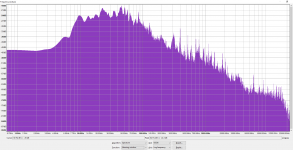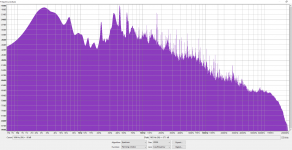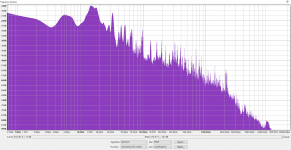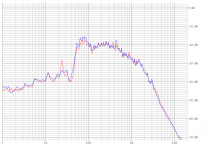Yes, a very good point, I manually add the main LS lifts to the subs I use below 25 Hz but only add about half of what they recommend as I have a house curve with a 4-6db lift
LORDSANSUI - I write my own software as a hobby. I am surprised there are not more hobbyist programmers on this site.
bitSmasher - I am too old to know about popular music after 1991. 😉
Ed
I write software for a living... and some for a hobby ( Raspberry Pi's ).
In practice I am EQ'd following a Harmon curve to 5 Hz, what difference does this make ?
More than you might think, obviously on film, it isn't any 'louder', not noticeable. On music you pick up more ambiance, sounds on the recording that might not be primary notes, but very much part of the live performance, resonance, movement and so on. It also seems to image better in that it sounds more like they are in the room, more real.
What people miss, particularly on film is that sense of reality. In real life you have all this accompanied low frequency pressure waves, remove it and you notice. The explosions and low frequency effects aren't louder just more visceral, powerful and real. A bus/lorry goes by, its not super loud but you can feel it and its part of the clue that its heavy
More than you might think, obviously on film, it isn't any 'louder', not noticeable. On music you pick up more ambiance, sounds on the recording that might not be primary notes, but very much part of the live performance, resonance, movement and so on. It also seems to image better in that it sounds more like they are in the room, more real.
What people miss, particularly on film is that sense of reality. In real life you have all this accompanied low frequency pressure waves, remove it and you notice. The explosions and low frequency effects aren't louder just more visceral, powerful and real. A bus/lorry goes by, its not super loud but you can feel it and its part of the clue that its heavy
I guess these graphs of movies are the average of the whole movie, or the average of the song?
In that case they might not tell the whole story as often in some movies there can be some, lets say 15 second very entertaining bass heavy content bursts, but the average long term level is low. Still, it's great fun to watch those short clips with friends. It even can be a bit tiresome if there is some constant nonstop unnatural rumbling trough out the whole movie.
In that case they might not tell the whole story as often in some movies there can be some, lets say 15 second very entertaining bass heavy content bursts, but the average long term level is low. Still, it's great fun to watch those short clips with friends. It even can be a bit tiresome if there is some constant nonstop unnatural rumbling trough out the whole movie.
Yes, my graphs are averages over the song. Classical music can vary, but pop/rock tends to be consistent throughout.I guess these graphs of movies are the average of the whole movie, or the average of the song?
Ed
It's out there.Here's my first attempt - very crude, not really seeking to prove anything other than satisfying my own curiousity.
Deep bass is like treble. You don't need anything above 3kHz to listen to the music, but it's vital for the illusion of reality. Same for below 30Hz. Without it, the music lacks the weight of the real instruments and shatters the illusion. I wish mastering engineers would break themselves of their bad old habits from the vinyl days and quit brick walling everything at 35Hz. It's cutting the legs out from under the music.
Attachments
Well, there was one movie with a lot of random bass, for example I remember in that one a guy put a coffee cup on the table and it had more bass than in an explosion in an other scene. Quite disturbing in a long run if it does not make any sense.Not for a basshead!
That's not uncommon. Explosion sounds tend to be added after the effect from blending samples from sound libraries. The cup could've come from the mic there or another sample from the foley artists that hadn't been high passed. I remember with the 2003 Battlestar Galactica series, all the onscreen explosions were beyond anemic with regards to bass, but anytime they shut a door on the ship softly, the low frequency transient would pop the doors in my listening room open.
Where was the recording venue? That spectrum looks like one of my studio builds directly over a subway. Fortunately the primary content was cold voice so draconian high pass filters were enough.I found something unusual.
I don't know the venue. It sounds like a studio recording.
ETA: Here is an example of a good recording. This is the "Blue Danube" performed by the Danish National Symphony Orchestra. I can see from the Youtube video that it was a live recording made with two microphones.
The very low frequency energy is diluted by the percussion not being constantly played.
Ed
ETA: Here is an example of a good recording. This is the "Blue Danube" performed by the Danish National Symphony Orchestra. I can see from the Youtube video that it was a live recording made with two microphones.
The very low frequency energy is diluted by the percussion not being constantly played.
Ed
Attachments
Last edited:
Guys, download these from Tom's site. Have a blast. I use couple of sealed subs equalized with APO equalizer down to 14Hz. And of course multiple amplifiers. Lowest end of the sound is a must have. Yes in pro audio it is not cost effective, but in home environment there is no reason, apart from subjective views of someone to not seek these kind of frequencies. If they are in real life (they exist there) even in High Fidelity logic it would be wise to try to reproduce them as true as possible. Note that Tom's audio is not synth or handled in some fashion, just natural recording. Do some Audacity there, you will find real life sound "picture".
https://www.danleysoundlabs.com/tom-danleys-mic-recordings/
https://www.danleysoundlabs.com/tom-danleys-mic-recordings/
The test is simple: Disconnect and connect your subwoofer while listening to music, you will feel the difference, the feeling of realism increases. 😊
A better test IMO is to play a song, and then play a 20hz tone on top of it. In my case the tone is super obvious when I do this. This is fun to do, even if you are alread a believer in subwoofers! The tone played over the song is more obvious than the same tone played by itself.
Doing that will show you the potential effect a good subwoofer can provide. But whether or not you benefit from a subwoofer is up to the content you are listening to.
I prefer to hear music as it was meant to sound, so I don't boost the bass. I enjoy it when songs or movies have a lot of low bass content, but I don't try to make classic rock sound like it had deep bass...because it just doesn't have any!
It seems fun 😉 , but I won't be able to do it for a while, I'm reforming the subwoofers from sealed to bass reflex....There have been opinions for and against, but the results of my simulations have encouraged me to embark on the adventure .......😊
https://www.diyaudio.com/community/...and-what-do-i-lose.392314/page-6#post-7249659
https://www.diyaudio.com/community/...and-what-do-i-lose.392314/page-6#post-7249659
Do it! People who dis' ported subs haven't heard a good one, or are just prejudiced.It seems fun 😉 , but I won't be able to do it for a while, I'm reforming the subwoofers from sealed to bass reflex....There have been opinions for and against, but the results of my simulations have encouraged me to embark on the adventure .......😊
https://www.diyaudio.com/community/...and-what-do-i-lose.392314/page-6#post-7249659
The tone played over the song is more obvious than the same tone played by itself.
Right, a note/tone needs its harmonics 'to be all it can be' and since the lower the note/tone the wider its BW, as low as ~11 Hz is required for some LFE content, low B pipe organ.
Sealed and BR have too much distortion. I prefer the sound coming out of a buried driver enclosure.
I respect your preferences, we all have ours. I am familiar with BR and other alignments that use the back of the driver in their job creating the sound pressure, but can you elaborate where exactly you do find the distortions in sealed subwoofers. I have 4x12" of them with total volume of nearly 500 liters and for my room (16 sq. m) there is no audible distortion at all. And they are equalized to 14 Hz.
horn_power: Have you measured the distortion? This gets academic and theoretical pretty quick...this stuff isn't actually audible in any obvious way. Distortion is a harmonic. You can't hear 14hz, but the distortion would be in the audible range. If you hear a tone when you play a 14hz tone, you are hearing distortion.
I'm not taking sides, but just curious. I've been trying to keep measured distortion low, but I haven't heard anything objectionable when I measured a little low frequency distortion.
I'm not taking sides, but just curious. I've been trying to keep measured distortion low, but I haven't heard anything objectionable when I measured a little low frequency distortion.
Hello, fredygump!
I used microphone and spectrum analyzer to check the performance, but when comes to sinusoidal samples human ear can pretty easily tell when there is distorted signal or any additional noise. With multiple drivers I use small amplitude from all of them and they easily can pressurize the room (heavily damped with DIY bass traps). The thing with different enclosure types is the need for checking with even music, but with impulse content. Every resonance enclosure, including the BR have near perfect response when comes to the sinusoidal tones, but when we try it with something else the problem is present. I don't take sides too. Just wanted the BP1Fanatic to give more info. I wanna educate myself with as more as possible info so to be perfect in my hobby. I made and tested thru the years many tapped horns, TL's bandpass horn hybrids, BR's, OB and even RiPols (don't like them, the RiPols...) and for high pressure outside I use TL. But for home these are my findings so far.
I used microphone and spectrum analyzer to check the performance, but when comes to sinusoidal samples human ear can pretty easily tell when there is distorted signal or any additional noise. With multiple drivers I use small amplitude from all of them and they easily can pressurize the room (heavily damped with DIY bass traps). The thing with different enclosure types is the need for checking with even music, but with impulse content. Every resonance enclosure, including the BR have near perfect response when comes to the sinusoidal tones, but when we try it with something else the problem is present. I don't take sides too. Just wanted the BP1Fanatic to give more info. I wanna educate myself with as more as possible info so to be perfect in my hobby. I made and tested thru the years many tapped horns, TL's bandpass horn hybrids, BR's, OB and even RiPols (don't like them, the RiPols...) and for high pressure outside I use TL. But for home these are my findings so far.
- Home
- Loudspeakers
- Subwoofers
- 10-25 Hz, is it necessary for HT or Music?




